Abstract. Expertise of the authenticity of cultural monuments made of metals and, in particular, historical edged weapons is now carried out on the basis of using a set of information about the technology of their manufacture, structural and morphological typology, chemical composition, and aggregate structure of metals. It is also important to study the existing brands, nouns and inscriptions, as well as evidence about the histo-ry of their existence from owners and managers. Based on comparison operations with related subjects that are well studied and described in detail by experts, the set of data mentioned above allows us to draw convincing conclusions about their origin and age. At the same time, these conclusions should be considered as congruent information, that is, one that confirms the expert's hypothesis, but is not true, final (existential) and does not deny the fundamental possibility of formulating alternative conclusions [1]. Conse-quently, the development of new analytical research methods that would allow determin-ing the age of metal monuments based on the use of theoretically based physico-chemical and mathematical models remains relevant and significant for expert practice.
Keywords: Introduction, X- Ray, microscopic examination, chemical composition of a metal, temperature, authenticity of cultural monuments.
Expertise of the authenticity of cultural monuments made of metals and, in particu-lar, historical edged weapons is now carried out on the basis of using a set of infor-mation about the technology of their manufacture, structural and morphological typolo-gy, chemical composition, and aggregate structure of metals. It is also important to study the existing brands, nouns and inscriptions, as well as evidence about the history of their existence from owners and managers. Based on comparison operations with related sub-jects that are well studied and described in detail by experts, the set of data mentioned above allows us to draw convincing conclusions about their origin and age. At the same time, these conclusions should be considered as congruent information, that is, one that confirms the expert's hypothesis, but is not true, final (existential) and does not deny the fundamental possibility of formulating alternative conclusions [1]. Consequently, the development of new analytical research methods that would allow determining the age of metal monuments based on the use of theoretically based physico-chemical and math-ematical models remains relevant and significant for expert practice.
The aim of the work is to experimentally test the scientific hypothesis that in the course of a long history of existence, the surface of objects made of iron alloys is freed from some of the impurity chemical elements - self-cleaning. Knowledge of this process can be used to confirm the authenticity of historical monuments. Assuming that the pro-cess of recrystallization of metal alloys and differentiation of their chemical composition under the influence of heating is significantly accelerated, the hypothesis formulated above can be experimentally confirmed.
The research was carried out on the basis of a fundamentally new method of using its chemical composition analyser to study the chemical composition of surface rubbing products [1] .
1Literature Review
Previous studies indicate that the steel surface of historical edged weapons for a long time of existence is covered with minerals formed from impurity chemical ele-ments, which are gradually eliminated from the metal alloy [1].
2Research Methodology
When heated, the heat released by the metal surface is transferred from the outer to inner layers due to thermal conductivity. When heated very quickly, the heat does not have time to spread from the metal surface inside. In this regard, there is a large differ-ence in the temperatures of the outer and inner layers, and the temperature expansion (increase in the volume of metal) of the inner layers lags behind the expansion of the outer layers. Significant mechanical stresses are created between the outer and inner lay-ers. They are larger the greater the temperature difference in the outer and deeper parts of the metal. Due to the large temperature difference, these stresses contribute to changes in the crystal lattices of the metal, which leads to the pushing out of a significant part of isomorphic chemical elements-impurities and the appearance of micro-solubility, where they accumulate.
The use of an X-ray fluorescence analyser to study the chemical composition of substances formed on the metal surface after it is warmed up makes it possible to find out the presence of chemical elements with different sizes of ions on it, and this fluently indicates the presence of traces of metal self-cleaning processes in the past. To study the chemical composition of surface substances, you can only use a special method of sam-pling, which involves rubbing the surface with a special swab and studying the chemical composition of substances that are concentrated in it.
Results
Note that significant heating of the clean surface of a metal (steel) product increases the chemical activity of free oxygen, exposure to water vapor and carbon acid. There-fore, it is easy to predict the chemical composition of substances that form on the sur-face. The appearance of the created surface formations resembles a crust, which is tradi-tionally called viburnum (Fig. 1). It is these formations that we use in further research.
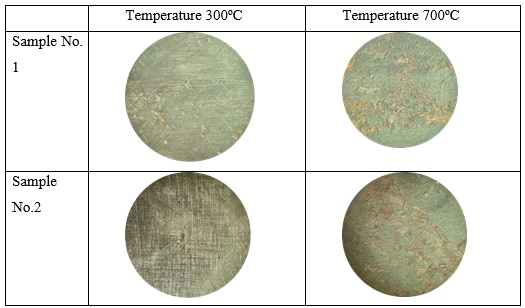
Figure 1. Microscopic examination of the sample surface at temperatures of 300⁰C and 700⁰C
If the metal is modern, chemical impurities are present in the metal (steel) evenly – on the surface and in deep parts, but if we are dealing with historical objects, the impuri-ty chemical elements in deep parts differ significantly in chemical composition from those obtained on the surface after warming up. The surface is self-cleaning and is al-most pure iron, impurity chemical elements are concentrated in the surface mineral crusts, and the chemical composition of the metal in deeper parts remains the same as it was originally.
The thickness of the layer of surface formations depends on the duration of the metal stay in the furnace. Active oxidation of the surface begins at temperatures equal to 600 - 700°C, and, of course, it can reach significant values at higher temperatures (about 900 -1000°C). In addition to the small mass loss of metal, the appearance of the outer surface of the metal worsens. After warming up, the surface is not smooth, but rough, covered with microcracks and negative relief elements, which contributes to the accumu-lation of eliminated chemical elements [2].
We should also note that when heated, the surface layer is decarburized in the met-al, since the carbon contained in the metal combines with the oxygen of the combustion product and burns out.
The study conditions assumed that the surface of two metal plates with dimensions of 3x3 cm and 5x5 cm was rubbed twice with a cotton swab at one point of the sample - before heating in a muffle furnace, and after gradual heating from 300°C to 700°C. Metal plates were placed on porcelain crucibles in order to minimize the contact of the surface of the plates in the furnace with each other and the walls of the furnace. Heating occurred gradually - first at a temperature of 300°C for one hour, and after complete cooling and studies of the chemical composition of the surface, the samples were reheat-ed to a temperature of 700°C for one hour. After their cooling, studies of the chemical composition of the surface were repeated. After each heating, rubbing was performed on the surface of the metal plates by two- or three-point frictions with a movement di-ameter of up to 1 cm, as a result of which chemical compounds formed by eliminated chemical elements remained on the cotton swabs.
To perform a comparative analysis of the chemical composition of the metal on the surface and in deeper parts, the plates were sanded with sandpaper at a certain point, af-ter which samples were again taken from the surface by rubbing with cotton swabs [3].
To increase the contrast of the study results obtained using an X-ray fluorescence device [1], cotton swabs were burned and this made it possible to concentrate substances in a small-volume sample and observe in more detail the ratio of concentrations of elim-inated chemical elements. The research used an Expert Mobile X-ray fluorescence ana-lyser (spectrometer) (manufactured by INAM LLC, Kyiv)
Thus, after heating to 300ºС, no visible changes in the chemical composition of substances on the metal surface were observed. However, after heating to 700°C, the pre-cleaned surface of the samples darkened, red oxides appeared, and the untreated sur-face of the metal plates turned black and showed signs of exfoliation of mineral crusts (scale).
The diagram allows us to state that the chemical composition of the metal surface changes significantly after heating and this confirms the process of elimination of chem-ical impurities from the metal. Given the fact that temperature exposure accelerates the process of self-cleaning metal, it is reasonable to assume that the same changes occur during a long time of existence of metal objects. For example, the delicately cleaned sur-face of metal parts of ancient edged weapons reveals a minimal content of chemical im-purities, while the chemical composition of metal in deeper parts from the surface re-veals a significant amount of them [3]. Taking into account the above and referring to the results of experiments, the prospects for creating appropriate criteria for proving the authenticity of objects and predicting their age are theoretically justified.
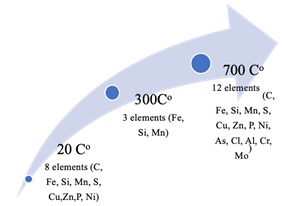
Figure 2. Changes in the chemical composition of a metal during its heating and the total amount of impurity elements
Thus, at room temperature (t ºC = 20 ºC), on the cleaned and sanded surface, we observe the real content of impurity chemical elements, which are initially present in the entire volume of Metal (Table 1; (sample No. 1, metal plate, size 3x3 cm, and sample No. 2, metal plate 5x5 cm). In the untreated areas of the samples, we observe the same chemical composition, but with higher concentrations of eliminated chemical elements. The result indicates the condition of the surface before the start of thermal exposure.
After heating the samples to 300 degrees Celsius, the chemical composition of the metal surface changes – light chemical elements - C, P, S - disappear, forming volatile compounds, and heavier atomic masses – Si, Mn, Cu, Ni – significantly increase their concentration (the reduced carbon content was not measured directly, but calculated us-ing software from the device manufacturer (INAM LLC). The calculation algorithm is not known for certain, but obviously the values are obtained by subtracting the differ-ence in iron peaks (and impurities) in the spectra of different reference alloys.).
After heating the samples to a temperature of 700 degrees Celsius, in addition to the chemical impurities indicated above, As, Al, and Mo appear on the surface.
Thus, the influence of temperature accelerates the elimination process and allows us to study its patterns, which should be associated with the size of the ions of the eliminat-ed chemical elements and the type and energy of chemical bonds that they have in the alloy [4].
Note that the proposed method for studying the chemical composition of a sub-stance on the metal surface in rubs provides for the possibility of generalizing the results by combining samples into one – mixing the ash of tampons, which relate to the results obtained at the same temperatures. This is certainly an advantage, because, as can be seen from the photo in Table 1 presented above, the aggregates and mineral crusts creat-ed on the surface are unevenly placed in space on the surface and for their analysis in the context of the research task, it is necessary to combine the material of all the corre-sponding samples obtained at the same temperatures.
To summarize numerous results ( up to 5 rubs at each of the specified tempera-tures), the study of determining the chemical composition of the surface uses a special algorithm that provides for calculating the corresponding amounts of concentrations of chemical elements obtained as a result of testing under the same heating conditions, after which the results are normalized by the value of one hundred percent (Table 2).
Thus, the final result of determining the features of the chemical composition of mineral compounds on the surface of the studied samples is calculated.
The surface composition of the test samples determined by RFA is shown in Table 1.
It should also be taken into account that iron has the highest concentrations in the studied samples. Its mass fraction in each rub ranges from 89 to 99% of the total mass of impurity elements. In addition, iron forms the largest number of compounds (oxides, carbides, and others.) during the heating process. At the same time, in the context of the task, the concentration of this chemical element is taken into account only as an indicator of the overall purity of the metal.
You can also see a tendency that as the temperature in the muffle furnace increases, the concentration of iron on the surface of the studied metal samples decreases, and the mass fraction of other elements increases (fig.3 and fig. 4).
As can be seen from the diagram, the values of the cleaned sample and the patina – free sample are close in value and are 96.145% and 99.113%, respectively. In a non-protected sample, the iron content in patina is much lower, and is 94.269 %.
Table 1. Results of studying the chemical composition on shooting ranges from the surfaces of the studied metal plates by the RFA method.
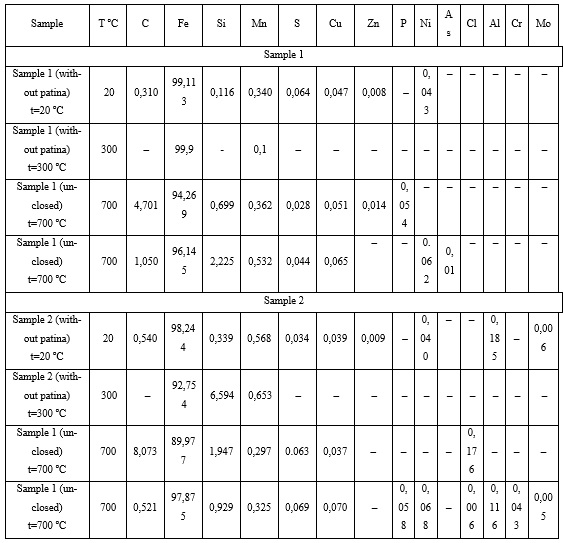
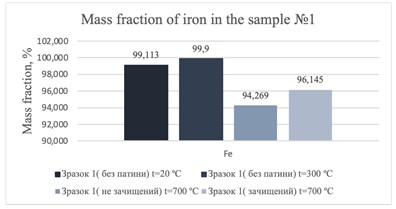
Figure 3. Mass fraction of iron in sample No.1
Sample 1 (without patina) t=20 ºC Sample 1 (without patina) t=300 ºC Sample 1 (unclosed) t=700 ºC Sample 1 (unclosed) t=700 ºC
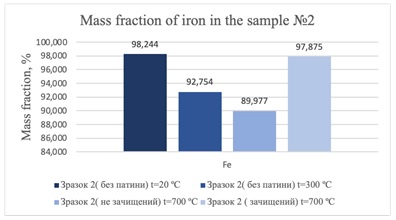
Figure 4. Mass fraction of iron in sample No. 2
Similar dynamics can be observed on the surface of the second sample. The values of the cleaned sample and the patina – free sample are similar in value and are 97.875% and 98.244%, respectively. In a non-protected sample, the iron content in patina is much lower, and is 89.997%.
In addition, the mass fraction of iron in the cleaned samples almost coincides with the mass fraction of iron in the samples at room temperature and is more than 97% of the total mass of impurity elements on the surface.
Also, at temperatures of 20ºС, a rather insignificant concentration of nickel was de-tected in both samples of each point sample. Nickel can also be observed on the shoot-ing ranges of cleaned samples No. 2 and No. 1.
Phosphorus is detected in both pupils only at a temperature of 700oc, as well as ar-sen. Their concentrations range from 0.0054-0.1%.
In sample No. 2, at a temperature of 300ºС, the programs could not correctly calcu-late the carbon content in the patina samples (due to the increased silicon content).
The composition of the patina can be observed in Figures 5 and 6. The rubs of samples No. 1 and No. 2 were shown at room temperature (t ºC = 20 ºC), at a tempera-ture of 700ºC, the surface condition is not cleaned, at a temperature of 700ºC, the sur-face condition is cleaned for greater clarity, the results in the diagrams were presented without the mass fraction of ferrum, the percentage value of which is 88% or more.
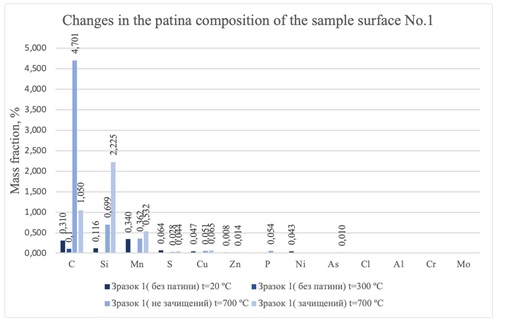
Figure 5. Changes in the surface patina composition of sample No. 1
Sample 1 (without patina) t=20 ºC Sample 1 (without patina) t=300 ºC
Sample 1 (unclosed) t=700 ºC Sample 1 (unclosed) t=700 ºC
As can be seen from Figure 5, increasing the temperature dramatically increases the amount of impurity elements. This increases the mass fraction of sulphur, manganese, and sulphur. The mass fraction of Cuprum and nickel also increased.
Also, among the total amount of impurities, there is a small amount of zinc and ar-sen. It is worth noting that such “emissions” are characteristic of cleaned samples, which can be a confirmation of changes in the crystal lattices of the metal, which leads to the pushing out of a significant part of isomorphic chemical elements-impurities and the ap-pearance of micro-compaction, where they accumulate, and that with the influence of temperature, chemical elements that were concentrated on the surface form scale.
Unfortunately, scale is not a stable structure, and has the peculiarity of peeling off from the surface and falling off. That is why the number of chemical elements on the unprotected surface is much lower than on the cleaned surface of the test samples.
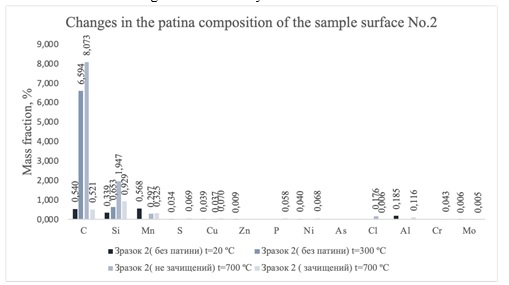
Figure 6. Changes in the surface patina composition of sample No.2
Sample 2 (without patina) t=20 ºC Sample 2 (without patina) t=300 ºC
Sample 2 (unclosed) t=700 ºC Sample 2 (unclosed) t=700 ºC
As can be seen from Figure 5, an increase in temperature affects an increase in the number of impurity elements. This increases the mass fraction of sulphur, manganese, and sulphur. The mass fraction of molybdenum, Cuprum and nickel also increased.
Among the impurity elements characteristic of the cleaned sample are also phos-phorus, arsen and chromium. But aluminium, on the contrary, was present only in the sample, which was not exposed to temperature.
3Conclusions
Changes in the chemical composition of the surface that occur during the long his-tory of objects made of metals are associated with the features of their aggregate struc-ture and changes in it, as well as the types of chemical ties and the size of the ions pre-sent in them.
The proposed method of testing the surface of metals is universal and useful for solving a number of expert tasks in the practice of forensic examinations, appraisal ac-tivities, antique and auction cases.
The results obtained allow us to optimistically assess the prospects for developing a universal methodology for confirming the authenticity of samples of historical edged weapons, as well as creating a list of criteria for determining their age.
References
1.Indutnyi V. V., Pokhodiashcha О. B. Expertise of cultural monuments. Kyiv: Litera LTD, 2021. p. 516
2.Indutnyi V., Merezhko N., Pirkovich K. Studying the authenticity of the golden element from a Mongolian warrior’s armor by physical-chemical methods. In: Eastern-European Journal of Enterprise Technologies. 2019. Vol. 1, N. 12 (97). P. 34–40. doi: https://doi.org/10.15587/1729-4061.2019.157156
3.Merezhko N., Vovk Y., Indutnyi V., Pirkovich K., Davydiuk V., Andreiev O. Devising criteria for the authenticity of historical cold weapons based on X-ray fluores-cence analysis of their surface. In: Eastern-European Journal of Enterprise Technolo-gies. 2021. Vol. 6, N. 12 (114). P. 6–11. doi: https://doi.org/10.15587/1729-4061.2021.247624
4.Indutnyi V., Merezhko N., Pirkovich K., Andreiev O. Identification of patterns of crystal-chemical transformations in historical artifacts made of metals.In: Eastern-European Journal of Enterprise Technologies. 2021. Vol. 1, N. 12 (109). P. 44–51. doi: https://doi.org/10.15587/1729-4061.2021.225418
|